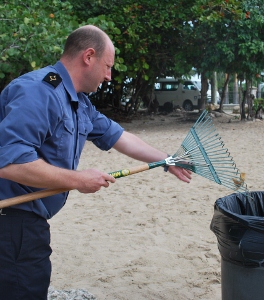Sailors spruce up Cayman beaches during shore leave
 (CNS): Crew from the Royal Fleet Ancillary (RFA) Fort Rosalie helped clean-up recently during a visit to Grand Cayman. Sailors gave staff from the parks and cemeteries unit a hand sprucing up Governor’s beach and Smith Cove despite the rain. “The visit to Grand Cayman was recreational; however, whenever the RFA ships visit, no matter their purpose, they are always willing to assist with community projects,” said Third Officer (Systems) George Counsell. “We thought it might be a nice idea to see if some of the crew could do something constructive on land to improve a small part of Cayman, whether it is building, painting, repairing or general tidying up."
(CNS): Crew from the Royal Fleet Ancillary (RFA) Fort Rosalie helped clean-up recently during a visit to Grand Cayman. Sailors gave staff from the parks and cemeteries unit a hand sprucing up Governor’s beach and Smith Cove despite the rain. “The visit to Grand Cayman was recreational; however, whenever the RFA ships visit, no matter their purpose, they are always willing to assist with community projects,” said Third Officer (Systems) George Counsell. “We thought it might be a nice idea to see if some of the crew could do something constructive on land to improve a small part of Cayman, whether it is building, painting, repairing or general tidying up."
the sailor also described the clean up as a "a nice break from the routine of the ship" as well as giving something back to the community.
Acting deputy in the ministry Jonathon Jackson was grateful tp the sailors for their time and effort. “Ugly trash on our beautiful beaches is not a good sight to see. The Recreation, Parks and Cemeteries Unit works hard to keep our beach clean. It is always good to get help and we thank the crew for doing their part.”
Fort Rosalie has been deployed in the Caribbean as part of Atlantic Patrol (North) (AP(N)) since the beginning of December, carrying out a number of official duties (e.g. relating to the recent UK/Caribbean Forum in Grenada) and activities related to drug interdiction. She has made stops in the United States, Jamaica, Grenada and now Grand Cayman.
It has a crew of 149, including 10 women. She is captained by Captain Ross Ferris,who was born in 1954 in Feock in Cornwall. He joined the Royal Fleet Auxiliary in 1972 as a Deck Cadet, initially aboard TS Worcester at Greenhithe on the Thames.
Built by Scott-Lithgow, Greenock the ship entered service as RFA Fort Grange in 1978. Her name was changed to RFA Fort Rosalie in 2000 to avoid confusion with RFA Fort George. When fully laden, she displaces 23,384 tonnes and with her Scott-Sulzer RND90 22,300 horsepower main engine, can achieve speeds of up to 22 knots. She is fitted with a bow thrust unit for slow speed maneuvering.
She can replenish warships and other RFAs at sea from a cargo of stores, victuals and ammunition. The flight deck is capable of operating four Westland Sea King helicopters and when carried, up to 45 Royal Navy air crew are embarked. The present Fort Rosalie is the second to bear the name. The first Fort Rosalie was a WW2 standard ship built by United Shipyards Canada. She entered RFA service in 1945 and served until 1973.
Fort Rosalie served in the Falklands Campaign in 1982, Operation Desert Storm 1991 and Operation Telic 2003.
Category: Local News

